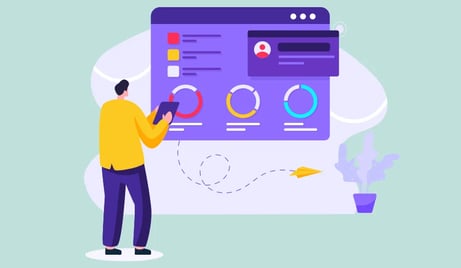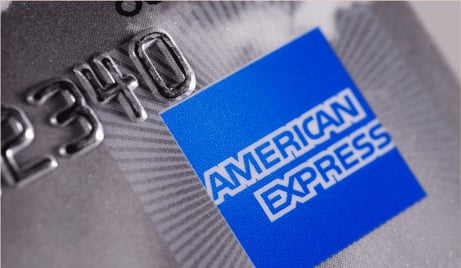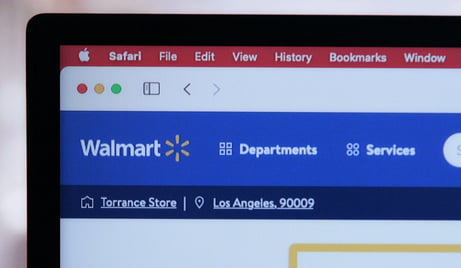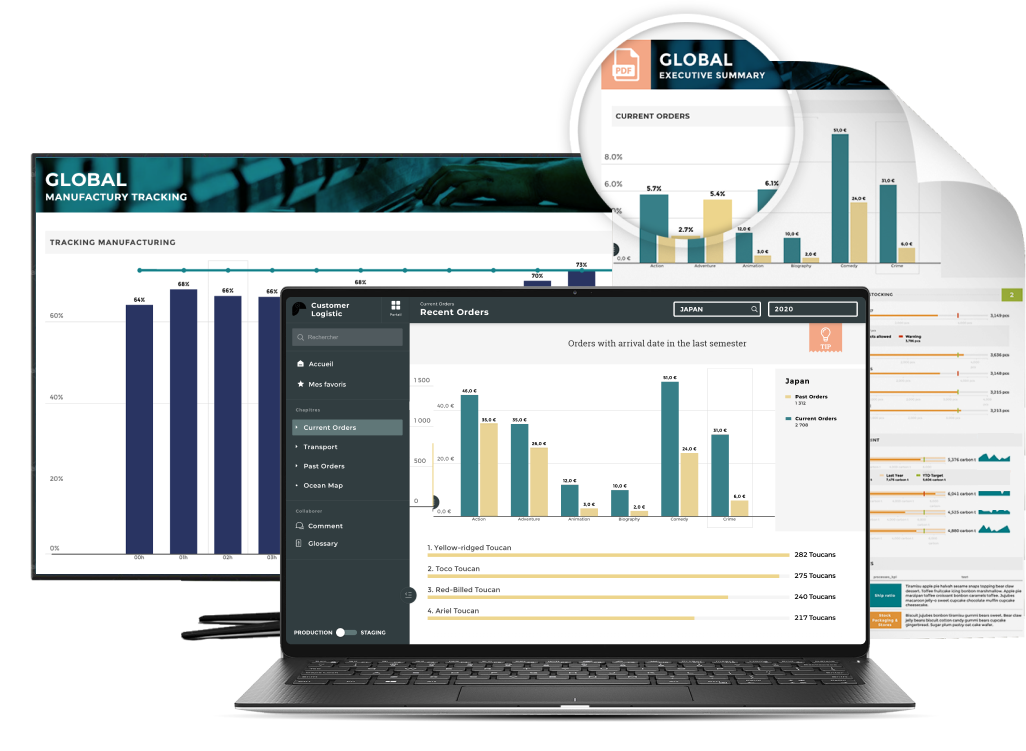Business intelligence (BI) is a technology-driven process for analyzing data. It is used to measure performance progress toward business goals, perform quantitative analysis, report and share data, identify customer insights, and much more. Business Intelligence enables businesses to organize, analyze and contextualize business data from all around the company.
In this article, we'll look at how some of today's top innovators are leveraging BI to shake up how they do things.

Common Business Intelligence Applications
Before we dive into the BI examples, let's (briefly) recap some of the contexts in which BI is often deployed:
-
Sales Intelligence
Knowing your audience and customer is key in any business. Using various reports and dashboards, BI makes understanding the customer journey extremely easy. It puts hard data in the hands of managers who can make vital decisions, on the go, to increase sales and stay ahead of the competition.
-
Providing Context for the C-suite
Data itself is often not useful in and of itself. With the sheer volume of data that's become ubiquitous today, what is actually important is making sense of the data and generating actionable insights from it, quickly. Since our brain process images 60,000 times faster than text, communicating data as visualizations make that task much easier. Today's top BI tools are providing context for executives with things like descriptions, glossaries, comments, and metrics all baked into the presentation.
-
Performance management
An integral part of growth is performance tracking;performance indicators setting clear goals for your company, employees, and yourself so that you can continue to track progress and course correct where necessary. BI makes it easy to understand where you are, how you stack up against the competition, and how effectively you're working towards meeting your most important objectives.
-
Internal Reporting
Understanding everyday product and service performance are crucial in determining both short-term and long-term goals. BI has the ability to process live data and give you the insights you need within seconds. This ensures that you don’t have to wait for analytics or data experts to help you understand your everyday performance indicators.
BI in ACtion: 4 real world examples
Okay, let's get to it! BI is being leveraged by many of the top innovators in virtually every industry, from coffee shops to airlines, and from e-commerce platforms to banks. The applications for BI are limitless, but here are some examples of how companies are using it today.:
-
Starbucks

Much of Starbucks' success can be attributed to their well-structured BI infrastructure and subsequent ability to make data-driven decisions quickly and on-the-fly. You've likely been to, or at least walked by, a Starbucks store at some point in your life - but have you ever wondered how they chose your favorite store location?
Starbucks carefully analyses a number of data points to identify what might make a successful store location. This includes:
- Consumer demographics
- Population density
- Average income levels
- Traffic patterns
- Public transport hubs
- Types of businesses in the location under consideration.
The breadth of this analysis is one of the contributing factors to the effectiveness of their store-level operations. But Business Intelligence doesn't stop here. For example, though most of Starbucks' menu items are standardized around the world, customs items and marketing vary (rather significantly) based on regions.
For example, the company ran a "Summertide - grab a Frappuccino” promotion during a heatwave in Memphis, and even started "Starbucks evenings" for stores in high alcohol-consuming areas that cater to those communities.
BI also has its hands in Starbucks' "My Starbucks rewards" program, where it's leveraged to track consumer behavior and generate tailored customer offers during the times that buyers are predicted to be most likely to purchase a beverage. This not only drives sales but also improves brand loyalty (Starbucks is able to give their customers exactly what they want, right when they want it).
-
American Express (AMEX)

American Express (AMEX) has been a mainstay in the finance world for some time. Their credit cards are thought to account for almost a quarter of the total dollar volume of credit card transactions in the United States, and they are viewed as one of the most valuable brands in the world. So how does this giant leverage BI?
The answer may not surprise you: a lot of ways!
AMEX operates on a closed-loop system, meaning they generate data about purchases from both the business and the cardholder's side. This gives them an amazing understanding of how businesses sell and how their cardholders buy. AMEX uses business intelligence to monitor this activity and use it to prevent fraudulent activities.
AMEX offers member benefits and, similarly to Starbucks, uses BI to tailor their member perks program to give customers what feels like an incredibly intimate member experience; one that accounts for their buying behavior, preferences, and spending habits. On top of that, AMEX is able to take things one step further and recommend restaurants and activities that the cardholder would enjoy (tracking the same data).
AMEX's digital innovation is evidenced by the fact that they are the only card provider that was able to drastically increase customer acquisition through online marketing and reduce costs by not relying heavily on direct mail. This has increased profits and laid the path for more targeted benefits, one of them being AMEX Express Checkout which makes online buying extremely easy.
-
Delta Airlines

When we think about the use of Business Intelligence in the airline industry, we might immediately look at it from a customer perspective. Seat allotments, ads, frequency of flights and locations, and so on. But when Delta Airlines implemented BI to improve the travel experience, it was for a whole other reason: baggage.
Delta has invested over $100 million (and counting) in BI systems to track and improve baggage handling. With the data collected and displayed in a digestible manner by the BI solution, teams at airports and in the Delta headquarters have been able to identify the root cause(s) of baggage mishandling and delays. This has enabled them to make fast and effective decisions that drastically reduce baggage loss and damage, making Delta the most reliable airline in terms of baggage and therefore improving their business.
Though Delta has applied BI extensively elsewhere in its business, the focus on baggage handling has allowed it to create a niche in an otherwise competitive industry with thin margins.
And, like the companies that appeared earlier on this list, Delta also uses BI to transform their passenger data into more effective loyalty programs that take all the best parts of travel and spending habits. They're able to target customers with their best promotions, right when they're likely looking to make a purchase. Not only is the airline able to secure a sale, but they are also able to cut down on their advertising spend.
-
Walmart

With 245 million customers visiting over 10,000 stores and 10 websites, Walmart was drowning in data.
The first data set Walmart started cleaning up came from its 10 websites, each of which used a 10-node Hadoop cluster to store data. In an attempt to unify its online presence, Walmart decided to transition to a single website and a 250-node Hadoop cluster that would serve as the foundation for all of its online customer data. Since Hadoop is an unstructured database, the biggest hurdle was preparing the data and getting actionable insights from it. This is where Business Intelligence came in.
BI helped streamline and visualize Walmart's data so that managers and executives could understand the numbers in these massive Hadoop clusters and make effective decisions to influence key business outcomes. On top of using BI to place products in front of customers at their time of need, Walmart also used BI to track the prices of various products in the market. This way, they always had a competitive advantage in terms of the cost of goods and were one step ahead of their competition at all times.
Today, most companies use BI to understand customer behavior and improve their bottom line. Some well-known examples are Uber, Twitter, Netflix, Lowe’s, Tesla, Chipotle, and Coca-Cola. But Business Intelligence isn’t just a one-trick pony. As seen by the examples above. The applications of BI are virtually endless. It is companies that ask the right questions and visualize data better than their competition that eventually stand out in the market.
Toucan is a customer-facing analytics platform that empowers companies to drive engagement with data storytelling. Ranked the #1 easiest to use analytics solution by Gartner Peer Insights, their no-code, cloud-based platform cuts custom development costs with a quick and easy implementation, even for non-technical builders. To find out what our users say, read their reviews on Capterra.





